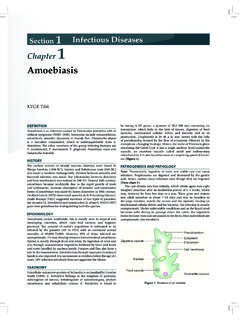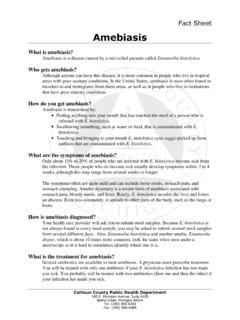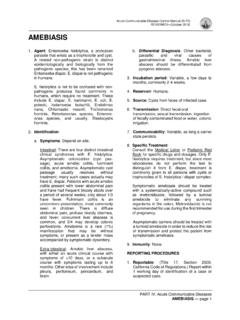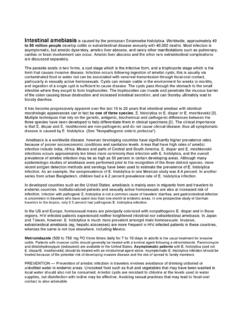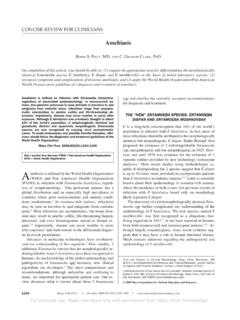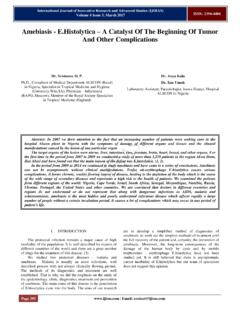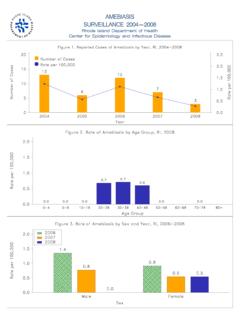Transcription of Progress towards Development of a Vaccine for Amebiasis
1 CLINICALMICROBIOLOGYREVIEWS,0893-8512/97 /$ 1997, p. 637 649 Vol. 10, No. 4 Copyright 1997, American Society for MicrobiologyProgress towards Development of a Vaccine for AmebiasisSAMUEL L. STANLEY, JR.*Department of Medicine and Molecular Microbiology, Washington UniversitySchool of Medicine, St. Louis, Missouri 63110 INTRODUCTION ..637E. OF A Vaccine TO PREVENT Amebiasis ..637 PARENTERALLY ADMINISTERED RECOMBINANT ANTIGEN-BASED Amebiasis VACCINES ..639 Serine-richE. histolyticaGal/GalNAc-Specific Lectin ..64129-kDa Cysteine-RichE. Vaccine of Current Vaccine Studies ..643 Development OF AN ORAL Vaccine TO PREVENT of RecombinantE. histolyticaAntigens with Cholera Toxin or Cholera Toxin B Subunit ..644 AttenuatedSalmonellaspp. as Delivery Systems for the Recombinant SREHP Molecule ..645 Limitations of Current Oral Vaccine ..646 REFERENCES ..646 INTRODUCTIONThe protozoan parasiteEntamoeba histolyticais the caus-ative agent of amebic dysentery and amebic liver abscess.
2 It hasbeen estimated that 50,000,000 people worldwide suffer fromdiarrhea secondary toE. histolyticainfection and that amebicdysentery and amebic liver abscess kill at least 50,000 individ-uals yearly (117). The disease is far more prevalent in devel-oping countries, and there appear to be regional hot spots forE. histolyticainfection where morbidity and mortality fromamebiasis seem especially high. Such regions include Mexico,South Africa, and India (117). The magnitude of the problemin Mexico has been illustrated by a recent nationwide serologicsurvey that showed that more than 8% of the Mexican popu-lation have had an episode ofE. histolyticainfection (10).While effective therapy for Amebiasis is available in the form ofthe drug metronidazole, the use of this agent does not appearto have had any significant effect on the prevalence of amebicinfection. The main mode of transmission of Amebiasis is theingestion of fecally contaminated food or water containingE.
3 Histolyticacysts; therefore, improved sanitary conditions areclearly the long-term approach to reducing or eliminating ame-biasis from areas of endemic infection. However, it is unlikelythat this will be accomplished in the near future. For thisreason, several laboratories have initiated efforts towards de-veloping a Vaccine to prevent amebic infection. In this review,I will discuss the scientific rationale for an Amebiasis Vaccine ,identify candidateE. histolyticaantigens for inclusion in a vac-cine, and summarize the recent Progress made in developingand testing both parenteral and oral recombinantE. histolyticaantigen-based vaccines for HISTOLYTICAINFECTIONE. histolyticais a parasitic ameba of the human gastrointes-tinal tract. It has a simple life cycle, existing only as the motiletrophozoite or the hardy, infective, nonmotile cyst stage ( ) (reviewed in reference 51).E. histolyticanaturally infectsonly humans and perhaps some higher nonhuman is established by ingestion of the cyst stage of theparasite.
4 After cysts pass through the stomach and the proxi-mal small bowel, they excyst to the motile trophozoite form,which colonizes and can penetrate the colonic mucosa. Understill undefined conditions within the colon, trophozoites encyst,and the infective cysts are passed out in the stool, where theycan infect new hosts. Trophozoites may be passed in the stoolas well, but they are noninfectious. Invasion of the colonicmucosa byE. histolyticatrophozoites results in diarrhea, whichis usually bloody (amebic dysentery). In roughly 5 to 10% ofindividuals with intestinal Amebiasis , theE. histolyticatropho-zoites invade through the colonic mucosa and reach the portalcirculation, which carries them to the liver. There they canestablish amebic liver abscess, a major cause of liver recently, one unexplained aspect of the epidemiologyof Amebiasis was the presence of a large number of asymptom-atic individuals who passed cysts but had no evidence for in-vasive disease.
5 Pioneering work involving isoenzyme analysis(85 87) and, more recently, molecular techniques (9, 14, 108,111) showed conclusively that there are two genetically distinctbut morphologically identical species of what was formerlyreferred to asEntamoeba histolytica. One species, which isclearly associated with disease in humans, is still referred to asEntamoeba histolytica. The second species, which is more prev-alent but does not appear to be associated with disease inhumans, is calledEntamoeba dispar. The Vaccine work re-viewed here deals solely withE. histolytica, the agent of amebicdysentery and amebic liver OF A Vaccine TOPREVENT AMEBIASISThe challenges in developing an effective Vaccine against anyinfectious disease are daunting, and parasitic diseases offer anumber of additional problems. In many cases, protozoan par-asites have complex life cycles with multiple hosts and stages.* Mailing address: Department of Medicine, Campus Box 8051, 660S.
6 Euclid Ave., St. Louis, MO 63110. Phone: (314) 362-1070. on December 19, 2020 by from These create problems both in the logistics of working with theparasite and in the identification of protective antigens, sincetarget antigens identified in one stage of the parasite may notbe expressed in another stage, thus limiting their effectivenessas Vaccine candidates. The presence of animal hosts for manyparasites also limits the possibility of eradicating the disease byvaccination, since these alternative hosts may provide a con-stant reservoir for infection of humans. Most of the clinicallyimportant protozoan parasites are predominantly intracellularparasites, thus providing limited opportunities for antibody-mediated protection, a critical correlate of much Vaccine -me-diated immunity. Fortunately, as noted above, most of theseproblems do not apply to Amebiasis . There are no insect vec-tors or secondary hosts involved in the transmission of amebi-asis, and a Vaccine that eliminated colonization and infectionof humans withE.
7 Histolyticacould eventually eradicate thedisease and the organism. Finally,E. histolyticais an extracel-lular parasite, thus providing a potential role for antibody invaccine-induced immunity to amebic important consideration in evaluating the feasibility of avaccine for Amebiasis is whether immunity to subsequent in-fection develops following a bout of Amebiasis . Those diseasesfor which protective and long-lived immunity develops follow-ing infection, such as mumps and smallpox, have been veryeffectively prevented by vaccines, while diseases for which thehost immune response to initial infection is only minimallyeffective or ineffective in preventing subsequent infection orchronic infection, such as malaria, appear to pose particularchallenges for successful Vaccine Development (70). Data onthe acquisition of immunity following infection withE. histo-lyticaare limited. In one epidemiologic study, individuals witha prior episode of amebic liver abscess had a much lower rate( during the study) of contracting a liver abscess than didpreviously uninfected patients based on historical controls(22), suggesting that prior infection may result in protectiveimmunity.
8 The experience of clinicians in areas of endemicinfection appears to support this concept (92), but carefullycontrolled prospective studies are simply not protective immunity can develop after amebic infection inhumans, how is it mediated? One possible mechanism involvesthe Development of anti-amebic antibodies. Individuals withamebic liver abscess develop anti-amebic antibodies, which areusually detectable within 1 week of the onset of symptoms (38,43). These anti-amebic antibodies form the basis of serologictests used to diagnose amebic liver abscess. The developmentof anti-amebic antibodies appears to have no effect on thecourse of amebic liver abscess, which has a high fatality ratewithout appropriate therapy (16). However, the failure of an-tibodies to alter the course of established amebic liver abscessdoes not mean that preexisting anti-amebic antibodies couldnot provide protection against subsequent infection (78).
9 Thelower inoculum associated with new infection, and antibodycontact with trophozoites in the bloodstream rather than inabscess tissue, might explain the difference in efficacy. Thereare experimental studies to support this concept. Hamsterspassively immunized with human immune serum and then in-trahepatically challenged withE. histolyticatrophozoites werepartially protected from amebic liver abscess (91). Recently,we demonstrated that human anti-amebic antibodies, obtainedfrom patients with amebic liver abscess, could protect micewith severe combined immunodeficiency (SCID mice) fromdeveloping an amebic liver abscess when the antibodies wereadministered before an intrahepatic challenge with virulentE. histolyticatrophozoites (93). Because SCID mice lack func-tional B or T lymphocytes, these studies clearly indicate thatpreexisting human anti-amebic antibody alone can protectagainst amebic liver abscess in this production of mucosal immunoglobulin A (IgA) anti-amebic antibodies after invasive intestinal Amebiasis could alsoplay a role in protecting against subsequent intestinal infectionwithE.
10 Histolytica. Anti-amebic antibodies of the IgA subclasshave been detected in saliva from patients with intestinal ame-biasis (11), and it has been demonstrated that human salivaryIgA anti-amebic antibodies can blockE. histolyticaadherenceto a mammalian cell line, suggesting that they could play a rolein inhibiting amebic infection/colonization in vivo (11). Thesefindings speak directly to the feasibility of developing an oralvaccine for Amebiasis that is capable of stimulating mucosalIgA anti-amebic antibodies that could block amebic adherenceto human intestinal epithelial role for cell-mediated immunity in protection againstamebiasis has also been investigated. Individuals with amebicliver abscess and intestinal Amebiasis develop T-cell prolifera-tive responses to amebic antigens following infection (81, 82,88, 115). When activated, macrophages from uninfected andpreviously infected individuals can kill amebic trophozoites invitro (82, 83). It has also been reported that lectin-stimulatedCD81T cells or amebic antigen-stimulated CD81T cells frompatients treated for amebic liver abscess have cytotoxic activityagainst amebic trophozoites in vitro (81, 82); but how suchkilling occurs in the absence of class I antigen expression onthe surface ofE.





